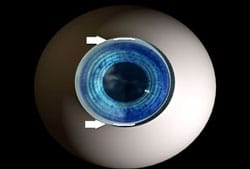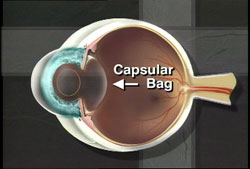In your parents’ or grandparents’ day, cataract surgery was considered risky, required a lengthy hospital stay, and was usually postponed until the “cataract got ripe”, a term no longer used today. Most of the decision to do surgery rests with the patient, based on their symptoms, and on advice from your eye doctor. Cataract surgery is performed on an outpatient basis and takes only a few minutes. It is now one of the most common and successful medical procedures performed by the hands of a skilled surgeon like North Dakota Eye Clinic Dr. Mark Sczepanski.
Over fifty percent of people over the age of 60, and quite a few younger than that, experience vision loss from cataracts. Currently, there is no medical treatment to reverse or prevent the development of cataracts. Once they form, the only way to see clearly again is to have them removed from within the eye by doing outpatient surgery.
Cataract surgery is for those who:
- believe that their quality of life has been impaired by poor vision, glare, distortion of colors, inability to read or drive, etc.
- have been diagnosed with cataracts by their doctor
What to expect on surgery day:
You will arrive at the surgery center about an hour or two prior to your procedure, depending on the testing that needs to be done. Some patients will require a complete eye exam if they have not been seen at North Dakota Eye Clinic before surgery day.

You must bring a driver with you on the day of surgery, or surgery will be cancelled. You may be able to drive yourself to your one day post-op check with your doctor.
Once you have been checked in to the surgery center, your medical history will be reviewed and you will be prepped for surgery. You will be given a sedative to help you relax. The area around your eyes will be cleaned and a sterile drape applied around your eye.
will be used to numb your eye. When your eye is completely numb, an eyelid holder will be placed between your eyelids to keep you from blinking during the procedure.

A very small incision will be made and a tiny ultrasonic probe will be used to break up the cataract into microscopic particles using high-energy sound waves. This is called phacoemulsification.
The cataract particles will be gently suctioned away. Then, a folded intra-ocular lens (IOL) will be inserted through the micro-incision, then unfolded and locked into permanent position. The small incision is “self-sealing” and usually requires no stitches. It remains tightly closed by the natural outward pressure within the eye. This type of incision heals fast and provides a much more comfortable recuperation.
Here you can create the content that will be used within the module.

and a tiny ultrasonic probe will be used to break up the cataract into microscopic particles using high-energy sound waves. This is called phacoemulsification. The cataract particles will be gently suctioned away. Then, a folded intra-ocular lens (IOL) will be inserted through the micro-incision, then unfolded and locked into permanent position. The small incision is “self-sealing” and usually requires no stitches. It remains tightly closed by the natural outward pressure within the eye. This type of incision heals fast and provides a much more comfortable recuperation. Here you can create the content that will be used within the module.

bag of the eye.
If your eye has pre-existing astigmatism, you will be offered a toric IOL, a lens placed inside your eye to correct for astigmatism. There is an extra charge for this lens that insurance does not cover. The surgeon can sometimes reduce small amounts of astigmatism based on the location of the incision. He may also elect to make micro-incisions in the cornea to reduce your astigmatism. These are called LRIs or limbal relaxing incisions which can be performed manually or with the LenSx® Femtosecond Laser. The manual procedure is not as predictable a procedure as the Toric IOL or the LenSx® laser.

can be treated with
limbal relaxing
incisions or the
LenSx Femtosecond
Laser.
During a twenty-minute stay in the recovery area, you will be instructed on the care of your eye and the use of eyedrops. You will go home soon after and relax for the rest of the day. Everyone heals at different rates, but many patients report improvement in their vision almost immediately after the procedure.

Most patients return to their normal activities within a day or two. The only limitation is heavy lifting. In most cases your doctor will see you for the one-day post op visit. You will then be seen again in one week and in one month. Glasses will be changed at the appropriate time by your doctor.
Realistic expectations:
The decision to have cataract surgery is an important one that you will make along with your doctor. The goal of any vision restoration procedure is to improve your vision. Once removed, cataracts will not grow back. Months after surgery, some patients may experience clouding of vision similar to when the cataract developed. This could be a sign of posterior capsular opacification, a clouding of the thin tissue, called the capsular bag, that holds the intra-ocular lens. In most cases, a laser is used to painlessly open the clouded capsule and restore clear vision with a procedure called a capsulotomy.
Serious complications with cataract surgery are extremely rare. It is a safe, effective and permanent procedure, but like any surgical procedure, it does have some risks. Going to a surgeon like Dr. Mark Sczepanski who does a large number of procedures, and thus is ready for any unexpected turns, can significantly minimize the risks involved with cataract surgery.

The capsular bag may become cloudy in the future.
After a thorough eye exam, you and your doctor will determine if cataract surgery is an option for you. You will be given additional information about the procedure that will allow you to make an informed decision about whether to proceed. Be sure you have all your questions answered to your satisfaction.


